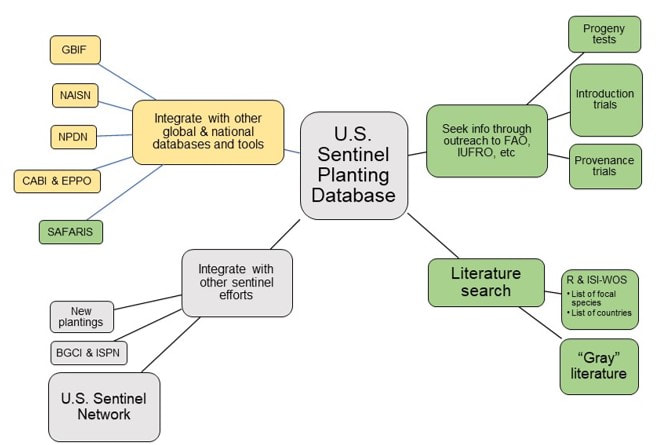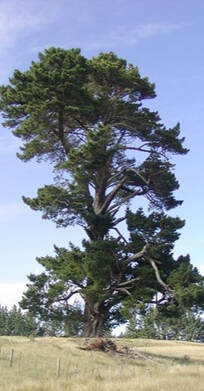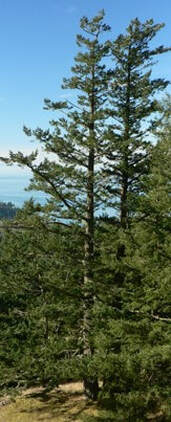Sentinel trees: surveillance for future invasive forest insects and pathogens (Led by USDA Forest Service, International Programs)
For more information: visit USDA Forest Service International Programs - Sentinel Network Info Site
|
Incense-cedar (Callitropis nootkatensis) in a public park in Glasgow, Scotland dying from a recently discovered species of Phytophthora currently only found in South America, Iran, and the United Kingdom.
|
Of the 1,432 tree species that are native to the U.S., 25% are designated as threatened, including 34% of species that are only found in the U.S. (BGCI 2021). Along with other conservation efforts, there is a need for pre-emptive knowledge of threats posed by nonnative invasive pathogens and insect pests that attack native tree species before they arrive in the U.S. (Susaeta et al. 2016, Li et al. 2021).
In the U.S., nonnative pathogens and herbivorous insects (= “pests” sensu U.S. Congress 2000, FAO 2015) of native forest trees are those that first arrived in the U.S. since European colonization but originated elsewhere. Host range and damage incurred by forest pests are frequently higher on more closely related host plant species (Parker and Gilbert 2004), but nonnative pests cause more damage to novel hosts with which they do not share recent evolutionary history (Gougherty and Jonathan 2021). Biogeography of native plant flora often features geographically disjunct distributions of closely-related taxa and when pests are transferred among these disjunct hosts they have a high likelihood of becoming invasive—causing damage to native host tree species; spreading unabetted; displacing other organisms; disrupting ecological processes; incurring costs to natural resources; and/or threatening the sustainability of ecosystem services and functions, and incurring social and economic costs. With respect to protecting U.S. natural resources, sentinel trees are trees that may be used for monitoring to provide early detection (Eschen et al. 2019), identification, and study of potentially invasive nonnative pests that may present a threat to native U.S. tree species. Ex patria sentinel trees are tree species native to the U.S. growing abroad and can provide a basis for proactive biosecurity measures, including quarantines; serve as monitoring resources for future threats; aid and reduce risk uncertainty; and jumpstart the development of effective management tools. Based on past and current experience, it is clear that ex-patria sentinel can help protect native species in the U.S. Had scientists heeded reports of A. planipennis on N. American ash (Fraxinus spp.) in the 1960s (Wang et al. 2010), more might have been done to prevent its introduction and/or limit the damage it caused before it arrived in the U.S. More recently, Phytophthora austrocedri has substantially impacted U.K. and Latin American species of Cuppressaceae in their home ranges (Green et al., 2012; Greslebin et al., 2007) but has also been found abroad on related hosts native to the U.S. (Green et al., 2016, unpublished data). Therefore P. austrocedri presents a threat to U.S. species and action should be taken to prevent and prepare for its introduction. Along the same lines, it was recently recommended to ban importation of Pinus seedlings to prevent introduction of Cronartium pini which is known to cause disease on at least two U.S. Pinus spp. in Eurasia, but knowledge is needed of its full potential host range on U.S. species, which may be available via sentinel surveys (Kim et al. 2021). In addition to parallel efforts to establish new plantings and to survey botanical gardens, U.S. native species have been established abroad > 100 years in plantations such as introduction, progeny and provenance trials that could be used as sentinels. Gathering information through literature review and international outreach, we will build a user-interface-accessible database of hosts, GIS locations and ages of plantations, observations of pathogens and pests, and damage. Once incorporated with parallel efforts, an accessible online tool will allow for rapid, real-time comprehensive risk assessment needed to justify restrictions for key species that pose a demonstrable threat in the U.S. For example, the risk to Pinus spp. in the U.S. was recently mapped via Spatial Analytic Framework for Advanced Risk Information Systems (SAFARIS) using climatic and host distribution data (Takeuchi 2021). To leverage all available data for comprehensive risk analysis, the database will be made available through a public interface, updated with new observations as needed, and integrated with the European Plant Protection Organization (EPPO) Global Database, Center for Agriculture and Biosciences International (CABI) Invasive Species Compendium, North American Invasive Species Network (NAISN), Botanical Garden Conservation International-International Sentinel Plant Network (BGCI-ISPN), Global Biodiversity Information Facility (GBIF), and other efforts, databases, and tools. A proof-of-concept will be completed for focal U.S. species including oaks (Quercus spp.), pines (Pinus), cedars (Cuppressaceae), and Pseudotsuga menzeisii. In addition to the main goal of enabling proactive biosecurity, there are additional downstream benefits to the global sentinel database. Sentinel trees in genetically diverse plantations can also provide pre-invasion information on resistance. For this reason, any available metadata on genetics, provenances and variation in damage will be included in the database. The database may also function as a tool to select candidates for research and development of biological controls if hosts are identified for which impact of a particular pest varies between home and ex patria ranges in similar climatic environments. |






